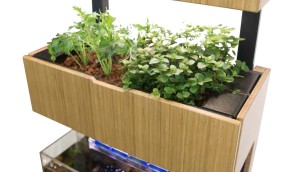Jamie Byron and Gabe Blanchet were seniors at MIT when Jamie built an indoor aquaponic garden and they harvested fresh salad greens, culinary herbs, and other fruits and vegetables throughout the winter. It didn’t take long for them to realize that that if they made the aquaponic systems aesthetically pleasing for people’s homes and adding technology to make growing plants easier, they could make the world a healthier happier place while building a valuable business. They founded “Greenlabs” and by 2014 they had 3 employees and a little over $2 million in funding, mostly from venture capitalists and angel investors. In January 2015 they started selling their home ecosystems in Boston. Gabe and Jamie nonetheless will openly say that they support outdoor farming. Gabe said, ”
“As a company we support any kind of personal farming, so if someone lives in Southern California and has room outside, they have no reason to buy a Grove — they should be harnessing that natural resource.” He humbly said, “Grove is for people like him who live in Boston, where the growing season is about four months and few people have space for a garden.
So how does it work? Anyone can purchase a 6-foot tall,  refrigerator size Grove in home ecosystem for around $4,500. When it is installed you can chose a unit to come in cherry, birch, mahogany, or bamboo. Blanchet recommends bamboo, because it’s the most sustainably harvested. Simply put, there is a fish tank at the bottom, and the ammonia in the fish waist is then filtered through the plants (while fertilizing them). The plants then, return the filtered clean water back to the fish. The ecosystem is lit with full-spectrum LEDs. The lights can be timed to brighten and shift spectrum throughout the day, starting red-hued in the morning, becoming bright and clear during the day, and then getting cooler and less intense in the evening. All of the lights and fans that come with the ecosystem can be controlled with an app on your smart phone! The app also includes a complete schedule reminding you when to tend to the ecosystem, even feeding the fish. “If you keep the system running optimally you can grow plants faster than you can outside,” says Blanchet.
refrigerator size Grove in home ecosystem for around $4,500. When it is installed you can chose a unit to come in cherry, birch, mahogany, or bamboo. Blanchet recommends bamboo, because it’s the most sustainably harvested. Simply put, there is a fish tank at the bottom, and the ammonia in the fish waist is then filtered through the plants (while fertilizing them). The plants then, return the filtered clean water back to the fish. The ecosystem is lit with full-spectrum LEDs. The lights can be timed to brighten and shift spectrum throughout the day, starting red-hued in the morning, becoming bright and clear during the day, and then getting cooler and less intense in the evening. All of the lights and fans that come with the ecosystem can be controlled with an app on your smart phone! The app also includes a complete schedule reminding you when to tend to the ecosystem, even feeding the fish. “If you keep the system running optimally you can grow plants faster than you can outside,” says Blanchet.
It sounds to me like it may be a hefty investment at the time, but can be very rewarding to people that put health high on the priority list and can afford it. Also, the product is appealing to people that just enjoy gardening as a hobby and can usually only enjoy it a few months out of the year.

No Comments
Categories : Uncategorized
millennialentrepreneurs.com
Copyright © 2025 All Rights Reserved
Copyright © 2025 All Rights Reserved